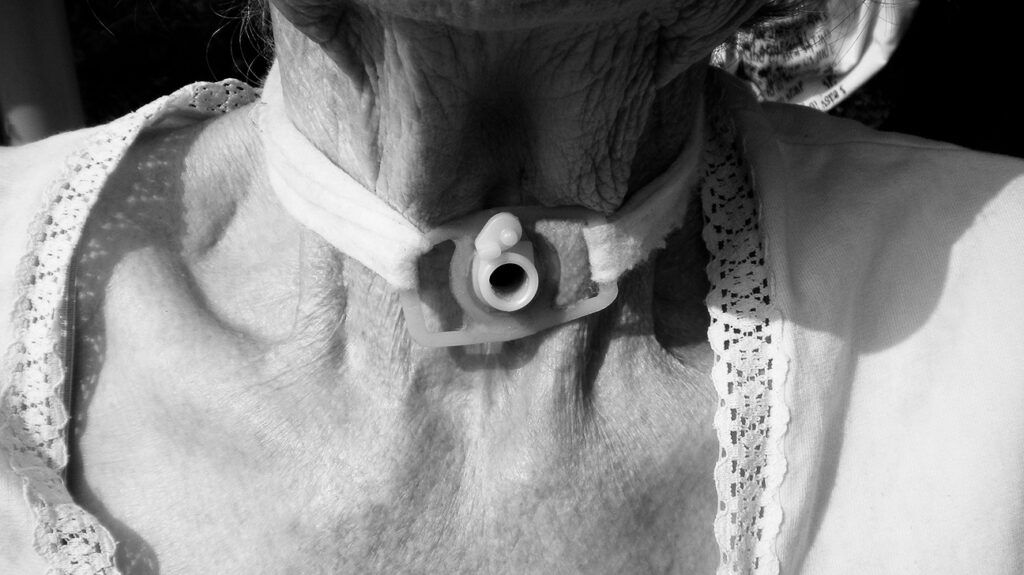A person with a tracheostomy has a higher risk than usual of aspiration, which means they may take unwanted substances into their airways.
A tracheostomy is a procedure in which a surgeon makes an opening in the front of a person’s throat and fits a tracheostomy tube into it. The tube connects the outside of the body with the lower airways.
A person may need a tracheostomy if they require some form of ventilatory support or have chronic respiratory failure. Whatever the underlying reason, a person with a tracheostomy is at risk of aspiration.
Here, learn more about why a person with a tracheostomy may experience aspiration and what to do if it happens.

A tracheostomy is a life saving surgery, but it involves some risks.
One risk is aspiration. Aspiration can happen when foreign material, such as food or spit, penetrates below the vocal cords. This can lead to breathing difficulties, infections, and other complications.
Who is at risk?
According to some research, aspiration is more likely to occur in people with a newly fitted tracheostomy. In a survey of 272 people with new tracheostomies,
Aspiration was twice as likely if the person did not have a cap or speaking valve in place. It was also more likely to occur in people who had a tracheostomy due to a tumor in the larynx (upper airway), surgery, or infection.
People should note that there are other reasons for needing a tracheostomy. Whatever the underlying reason, there is still a risk of aspiration.
Someone with a new tracheostomy may also have difficulty swallowing, known as dysphagia. This can increase the risk of aspiration.
A speech and language pathologist (SLP) can assess swallowing and aspiration risk in a person with a newly fitted tracheostomy.
A person may know at once if an unwanted substance enters the lungs, but aspiration can also be “silent,” meaning the person is unaware. In the study mentioned above,
Here are some signs of aspiration that may occur at once or appear over time:
Coughing or choking
If dust, food, secretions, fluid, or other substances get through the vocal cords, a person may experience irritation, leading to coughing or choking.
However, a person may not necessarily always cough when liquid sprays into the tracheostomy.
Aspiration pneumonia
If particles remain in the lungs, aspiration pneumonia can develop.
Signs of aspiration pneumonia can appear suddenly and include:
- breathing difficulty
- low oxygen levels, which may lead to blue-tinged lips or nail beds
- fever
For people with silent aspiration, these may be the first signs.
Statistics suggest that aspiration pneumonia is life threatening in
Whether or not they have a tracheostomy, people might occasionally experience aspiration when eating and drinking. It might feel like food or liquid “going down the wrong pipe.”
However, anyone with a tracheostomy who experiences breathing difficulty or has signs of low oxygen levels needs urgent medical attention.
A person with a tracheostomy will undergo a swallow evaluation before being able to take in food orally. So, they should be able to eat and drink like someone who has not had a tracheostomy.
Between
Evaluation methods
To test how well a person can swallow, a doctor may use a Fiberoptic Endoscopic Evaluation of Swallow (FEES) test.
This test involves the following steps:
- A doctor inserts a scope, a thin tube with a camera, through the person’s nose and into their larynx.
- The doctor provides liquids and solids through the mouth.
- The doctor observes onscreen to assess the swallow function and where the food goes.
An alternate test that healthcare professionals might use instead of the FEES test is a modified barium swallow test.
The doctor will discuss the results with the individual and use them in the rehabilitation plan.
Assessment of swallow function by an SLP before oral feeding is a very important step to reduce the risk of aspiration. SLPs can also help with any communication and speech difficulties a person with a newly fitted tracheostomy may have.
Sometimes, a specialist may suggest a tracheostomy tube with an inflated cuff to minimize the risk of aspiration.
Another tip for preventing aspiration and other problems is to follow medical advice closely and learn how to use and maintain the device safely at home.
Learn more about how to care for a tracheostomy.
What does aspiration mean in tracheostomy?
Aspiration can happen when foreign material, such as food or spit, penetrates below the vocal cords. A person with a tracheostomy, especially a newly fitted one, may be at risk of experiencing aspiration.
What are the signs of silent aspiration?
Silent aspiration does not produce any signs when it happens, but it can increase the risk of pneumonia. Symptoms of aspiration pneumonia include breathing difficulty, a fever, and a blue tinge to the lips due to low oxygen levels.
However, these symptoms may only show up with chronic or recurrent aspiration.
What are the warning signs of tracheostomy tube obstruction?
Obstruction
Aspiration is when unwanted substances, such as food or spit, enter the airways and penetrate the vocal cords. It can lead to coughing or more serious complications, such as aspiration pneumonia. People with a newly fitted tracheostomy may have a higher risk of aspiration.
Working with a speech and language pathologist can help reduce the risk of aspiration with a tracheostomy, as can learning how to maintain and use the equipment.
Anyone with a tracheostomy who has breathing difficulty needs urgent medical attention.
